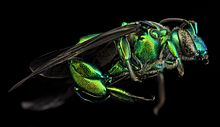Exaerete

| Exaerete | |
|---|---|
 | |
| Exaerete frontalis | |
| Scientific classification | |
| Domain: | Eukaryota |
| Kingdom: | Animalia |
| Phylum: | Arthropoda |
| Class: | Insecta |
| Order: | Hymenoptera |
| Family: | Apidae |
| Tribe: | Euglossini |
| Genus: | Exaerete Hoffmannsegg, 1817 [1] |
Exaerete is a genus of euglossine bees[2] found from Mexico to northern Argentina. Like all orchid bees, they are restricted to the Neotropics. All but one species is metallic green, and they are cleptoparasites in the nests of other euglossines in the genera Eufriesea and Eulaema.[3][4] It contains the following species:[4][5]

- Exaerete azteca Moure, 1964
- Exaerete dentata (Linnaeus, 1758)
- Exaerete fallaciosa Engel, 2018
- Exaerete frontalis (Guérin-Méneville, 1845)
- Exaerete kimseyae Oliviera, 2011
- Exaerete lepeletieri Oliviera & Nemesio, 2003
- Exaerete salsai Nemesio, 2011
- Exaerete smaragdina (Guérin-Méneville, 1845)
- Exaerete tricosa Engel & Bembé, 2020
- Exaerete trochanterica (Friese, 1900)
References
[edit]- ^ "Exaerete Hoffmannsegg, 1817". Integrated Taxonomic Information System. Retrieved 12 June 2008.
- ^ Sydney A. Cameron (2004). "Phylogeny and biology of Neotropical orchid bees (Euglossini)". Annual Review of Entomology. 49: 377–404. doi:10.1146/annurev.ento.49.072103.115855. PMID 14651469.
- ^ Norris H. Williams & W. Mark Whitten (1983). "Orchid floral fragrances and male euglossine bees: methods and advances in the last sesquidecade". The Biological Bulletin. 164 (3): 355–395. doi:10.2307/1541248. JSTOR 1541248.
- ^ a b Andre Nemesio (2011). "Exaerete salsai sp. n. (Hymenoptera: Apidae): a new orchid bee from eastern Brazil" (PDF excerpt). Zootaxa. 2967: 2–20.
- ^ Engel, M.S. (2018). "A new species of the cleptoparasitic orchid bee genus Exaerete from northern Venezuela (Hymenoptera: Apidae)". Entomologist's Monthly Magazine. 154 (3): 161–175. doi:10.31184/M00138908.1543.3949. S2CID 91665807.
External links
[edit]- David Roubik (Smithsonian Tropical Research Institute): Diagnostic photographs of several Exaerete species